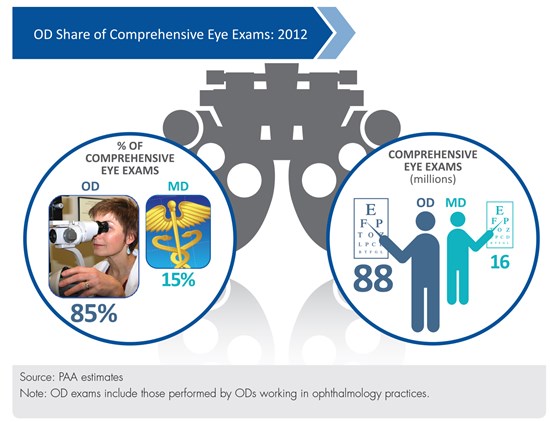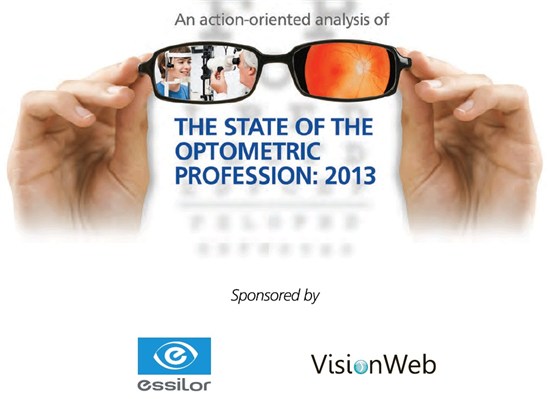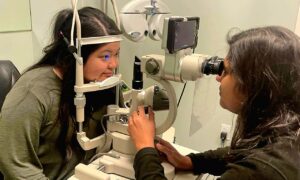The following content highlight from The State of the Optometric Profession analyzes the output of eyecare across varied segments of American society—and provides strategies for growing an optometric practice.
>>Click HERE or image on right to download the report>>

An overwhelming majority of Americans rely on optometrists for primary eyecare. ODs perform an estimated 88 million refractive eye exams annually of the total of 104 million performed by all eyecare professionals, or 85 percent of all comprehensive eye exams. ODs prescribe at least 90 percent of vision correction devices. Optometry’s commanding share of the primary eyecare market has steadily increased, as the number of practicing ODs has grown by 1.8 percent annually, and the number of practicing ophthalmologists has been stable.
Comprehensive eye exams and sales of corrective devices are the principal sources of OD revenue, typically accounting for 80 percent or more of collected billings among independent practice ODs. Despite ODs’ large annual output of primary eyecare, most ODs have not maximized the frequency of patient visits by achieving high patient compliance with a yearly eye exam regimen.
It’s estimated that the 198 million people who use vision correction devices receive just 94 million exams annually, equivalent to one exam every 25 months. This occurs even as ODs encourage most patients to have yearly eye exams. If ODs were to reduce the average interval between eye exams from 25 months to 18 months, ODs would perform an additional 34 million eye exams annually, a 39 percent increase.

As ODs’ scope of practice has broadened, medical eyecare services have become a larger source of OD revenue. Of the 97 million patient visits to offices owned by ODs in 2012, including both independent practice and corporate affiliated offices, nearly 18 million were for medical eyecare services.
Medical eyecare services performed by ODs include monitoring of ocular complications from diabetes and treatment of ocular infection, dry eye, ocular allergies and glaucoma. In the median independent practice OD office, medical eyecare accounts for 17 percent of total patient visits and 17 percent of revenue. Corporate affiliated ODs are somewhat less active in providing medical eyecare services than are ODs working in independent practices. It’s estimated that 80-85 percent of ODs have some level of involvement with medical eyecare, but in less than 25 percent of practices is this a major source of income. A majority of OD practices have not fully developed this revenue source.
Independent practice ODs dispense 26.5 million pairs of eyeglasses annually, representing 32 percent of total units sold. Commercial providers, primarily optical chains, command a 54 percent market share of eyewear units dispensed. In recent years, independent practice ODs’ share of US eyewear revenue has slowly increased.

Because ODs in independent practice settings perform 44 percent of the refractive exams, it’s apparent that a significant number of patients of independent practice ODs choose to buy eyewear from commercial providers. It’s estimated that independent practice ODs capture just 73 percent of the eyewear purchases of their patients. The walkout represents an annual loss of sales of 9.8 million pairs, with a retail value of $2.2 billion, according to Vision Watch and PAA estimates.

ODs’ dominance of contact lens dispensing is greater than their dominance of eyewear dispensing. It’s estimated that ODs account for nearly 90 percent of the contact lens prescriptions written annually. In part this is because the average age of the patient population in OD offices is typically lower than in ophthalmologist offices, and the average age of contact lens wearers is lower. Independent practice ODs sell nearly half of contact lens units.
Contact lenses have accounted for a steadily increasing share of OD revenue since the 1970s. Contact lens penetration in the US continues to increase, and is currently estimated to be 16.1 percent of US adults. Contact lens exams account for 27 percent of the refractive exams performed by ODs.

As with eye exams, medical eyecare and eyewear dispensing, ODs do not realize the full revenue potential of their contact lens wearer bases. Typically, 20 percent of contact lens purchases of patients of independent practice ODs are made with optical chain and internet sellers. ODs also achieve a relatively low level of patient compliance with lens replacement recommendations, resulting in sub-optimal annual consumption of lenses.
Over the past 10 years, ODs performed an increasing share of the comprehensive eye exams reimbursed by Medicare, reflecting the increased numbers of ODs available to serve the public, relative to the number of ophthalmologists.
Actionable Strategy Imperatives
This overview of ODs’ output and competitive situation identifies several priorities for ODs to improve office processes to increase market share:
Improve recall processes. Many ODs invest too few resources to patient recall, ceding control over the timing of exam visits to patients. Less than half of OD independent practices, and fewer than 20 percent of corporate-affiliated practices, pre-appoint patients. Independent practice ODs spend a median of less than $1 on recall activities for each exam performed. Only half of practices have a staff member assigned responsibility for recall. The result is a longer than desired average interval between exams, weaker patient loyalty and lost revenue. Every practice requires a rigorous recall process.
Upgrade eyewear purchase experience. Independent practice ODs experience lower than desired capture rates of patient eyewear purchases, largely because they devote too little management attention to eyewear merchandising. Optical chains have a competitive advantage in eyewear merchandising, which independent practice ODs must work to minimize, if they desire to preserve this revenue source.
Broaden scope of practice. There are many benefits that accrue to ODs who operate at the full scope of practice authorized by their licensing state. Providing a broader range of vision and eye health services to patients is an effective practice growth strategy with major potential to expand revenue.


























